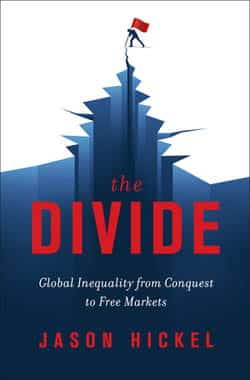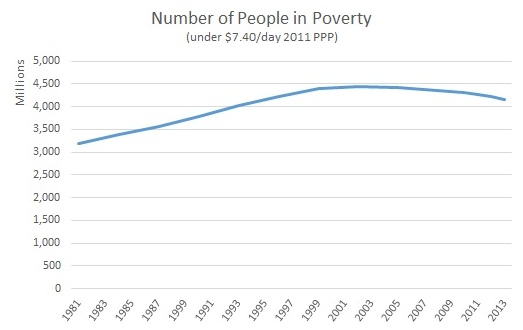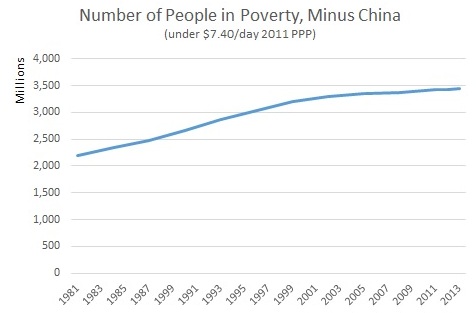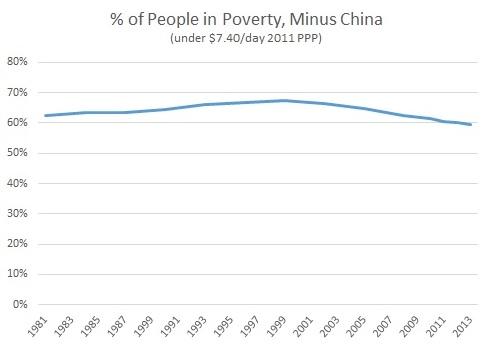Jason Hickel is the author of The Divide: Global Inequality from Conquest to Free Markets (WW Norton, 2017). This article is reposted, with permission, from his blog.
Dear Steven,
I’m writing to respond to a letter you posted regarding claims I made in the Guardian about the global poverty narrative. I’m addressing you directly because I think it’s preferable to engaging in back-channel debates, and because I’d like to invite you to respond to what follows. This is an important question and it demands serious, honest engagement.
The point of my piece was that the story of global poverty is more complex than you and Gates have been willing to acknowledge, and the data do not support your narrative about neoliberal globalization. Let me elaborate on my key points here, to clear up any confusion, while also addressing your specific comments.
First, the long-term poverty graph (1820-present) developed by Max Roser and recently tweeted by Bill Gates is misleading and has little empirical legitimacy. There are a few reasons for this.
Real data on poverty has only been collected since 1981, by the World Bank. It is widely accepted among those who research global poverty that any data prior to 1981 is simply too sketchy to be useful, and going back to as early as 1820 is more or less meaningless.
The data for 1820-1970 comes from a source (Bourguignon and Morrisson 2002) that draws on the Maddison database on world GDP. That data was never intended to assess poverty, but rather the distribution of global GDP – and that for only a limited range of countries. We might try to speculate about the share of GDP that the poorest people had, but that’s very different from telling us anything very useful about poverty.
It is important to recognise that the graph mixes two very different measures. The measure for 1820-1970 is purely income-based. In other words, it excludes the non-monetary goods and resources that people may have acquired from their land, from trees, from forests, from rivers and the sea, and in the form of gifts from relatives. By contrast, the World Bank’s measure for 1981ff is consumption–based – it includes not only income but also the monetary value of all non-monetary transactions.
These two disparate measures cannot be united into a single long-term trend. Roser’s graph attempts to do so, but it is not peer-reviewed, and to my knowledge there is no actual scholarship that underwrites this move. It might make for nice social media, but it’s not rooted in science.
In fact, uniting the two methodologies is misleading in both directions. (1) By assessing only income from 1820-1970 it likely understates the resources that people had at their disposal in comparison to the representation of the later period, and (2) By assessing total consumption from 1981ff it overstates people’s income in comparison to the representation of the earlier period.
The only way to construct a legitimate long-term graph would be to use a single indicator, either income or consumption. While data on income alone is not regarded as a robust way of assessing poverty, it is at least available (if too patchy to be useful) for the whole period. But in such a graph the falloff in poverty since 1981 would not be nearly as steep, as it would not count non-monetary transactions. Alternatively, we could wait until someone devises a reasonable method for measuring poverty in consumption-based terms since 1820. But in the meantime, I think it’s wise to refrain from making claims about long-term poverty trends that lack empirical validity.
You say: “Hickel’s picture of the past is a romantic fairy tale, devoid of citations or evidence.” On the contrary, as the above makes clear, it is the graph of the past on which you so glibly rely that is devoid of evidence.
As to my actual claims about the past, my argument was straightforward. I simply pointed out that we cannot ignore the fact that the period 1820 to circa 1950 was one of violent dispossession across much of the global South. If you have read any colonial history, you will know colonizers had immense difficulty getting people to work on their mines and plantations. As it turns out, people tended to prefer their subsistence lifestyles, and wages were not high enough to induce them to leave. Colonizers had to coerce people into the labour market: imposing taxes, enclosing commons and constraining access to food, or just outright forcing people off their land.
You ask for citations. Here are some you might try: Sven Beckert’s Empire of Cotton, Ellen Wood’s The Origins of Capitalism: A Longer View, Mike Davis’ Late Victorian Holocausts, Adam Hochschild’s King Leopold’s Ghost, and of course Karl Polanyi’s The Great Transformation.
The process of forcibly integrating colonized peoples into the capitalist labor system caused widespread dislocation (a history I cover in The Divide). Remember, this is the period of the Belgian labor system in the Congo, which so upended local economies that 10 million people died – half the population. This is the period of the Natives Land Act in South Africa, which dispossessed the country’s black population of 90% of the country. This is the period of the famines in India, where 30 million died needlessly as a result of policies the British imposed on Indian agriculture. This is the period of the Opium Wars in China and the unequal treaties that immiserated the population. And don’t forget: all of this was conducted in the name of the “free market.”
All of this violence, and much more, gets elided in your narrative and repackaged as a happy story of progress. And you say I’m the one possessed of romantic fairy tales.
The Maddison database on which you rely might tell us what the dispossessed gained in income (eventually), but it does not tell us whether those gains offset their loss of lands, commons, supportive communities, stable local economies. And it tells us nothing about what global South economies might be like today had they been free to industrialize on their own terms (take the case of India, for instance).
Let me be clear: this is not a critique of industrialization as such. It is a critique of how industrialization was carried out during the period in question. If people had willingly opted into the capitalist labor system, while retaining rights to their commons and while gaining a fair share of the yields they produced, we would have a very different story on our hands. So let’s celebrate what industrialization has achieved – absolutely – but place it in proper context: colonization, violence, dispossession and all. All we gain from ignoring this history is ignorance.
Now, to the present period.
You say that the “massive fall of global extreme poverty” is simply a neutral fact of the data. But here again the data on this is more complex than you have ever acknowledged (I collaborated with Charles Kenny to review the basics here).
The narrative that you and Gates peddle relies on a poverty line of $1.90 per day. You are aware, I’m sure, that this line is not a neutral phenomenon, handed down by the gods or given in nature. It was invented by people, is used for particular ends, and is hotly contested both inside and outside of academia. Most scholars regard $1.90 as far too low to be meaningful, for reasons I have outlined in my work many times (see here and here). See Reddy and Lahoti’s withering critique of the $1.90 methodology here.
Here are a few points to keep in mind. Using the $1.90 line shows that only 700 million people live in poverty. But note that the UN’s FAO says that 815 million people do not have enough calories to sustain even “minimal” human activity. 1.5 billion are food insecure, and do not have enough calories to sustain “normal” human activity. And 2.1 billion suffer from malnutrition. How can there be fewer poor people than hungry and malnourished people? If $1.90 is inadequate to achieve basic nutrition and sustain normal human activity, then it’s too low – period. It’s time for you and Gates to stop using it. Lifting people above this line doesn’t mean lifting them out of poverty, “extreme” or otherwise.
Remember: $1.90 is the equivalent of what that amount of money could buy in the US in 2011. The economist David Woodward once calculated that to live at this level (in an earlier base year) would be like 35 people trying to survive in Britain “on a single minimum wage, with no benefits of any kind, no gifts, borrowing, scavenging, begging or savings to draw on (since these are all included as ‘income’ in poverty calculations).” That goes beyond any definition of “extreme.” It is patently absurd. It is an insult to humanity.
In fact, even the World Bank has repeatedly stated that the line is too low to be used in any but the poorest countries, and should not be used to inform policy. In response to the Atkinson Report on Global Poverty, they created updated poverty lines for lower middle-income ($3.20/day) and upper middle-income ($5.50/day) countries. At those lines, some 2.4 billion people are in poverty today – more than three times higher than you would have people believe.
But even these figures are not good enough. The USDA states that about $6.7/day is necessary for achieving basic nutrition. Peter Edwards argues that people need about $7.40 if they are to achieve normal human life expectancy. The New Economics Foundation concludes that around $8 is necessary to reduce infant mortality by a meaningful margin. Lant Pritchett and Charles Kenny have argued that since the poverty line is based on purchasing power in the US, then it should be linked to the US poverty line – so around $15/day.
The literature on this issue is now vast and nuanced – I have only scratched the surface here – and yet you pretend it doesn’t even exist. That is intellectually irresponsible, and an inadequate approach to scholarship.
You say: “The level at which one sets an arbitrary cutoff like ‘the poverty line’ is irrelevant — the entire distribution has shifted, so the trend is the same wherever you set it.”
Not so fast. In fact, the story changes quite a bit – and you know it. If we use $7.40 per day, we see a decline in the proportion of people living in poverty, but it’s not nearly as dramatic as your rosy narrative would have it. In 1981 a staggering 71% lived in poverty. Today it hovers at 58% (for 2013, the most recent data). Suddenly your grand story of progress seems tepid, mediocre, and – in a world that’s as fabulously rich as ours – completely obscene. There is nothing worth celebrating about a world where inequality is so extreme that 58% of people are in poverty, while a few dozen billionaires have more than all of their wealth combined.
That’s proportions. Don’t get me wrong: proportions are an important indicator – and we should pay attention to it. But absolute numbers are equally important. In fact, that is the metric that the world’s governments first agreed to target in the Rome Declaration in 1996, the precursor to the Millennial Development Goals. The goalposts were shifted to proportions in the following years, which created the impression of faster progress. But really now it’s a moot point: if the goal is to end poverty, what matters is absolute numbers. Certainly that’s what matters from the perspective of poor people themselves.
And if we look at absolute numbers, the trend changes completely. The poverty rate has worsened dramatically since 1981, from 3.2 billion to 4.2 billion, according to World Bank data. Six times higher than you would have people believe. That’s not progress in my book – that’s a disgrace. It is a crushing indictment of our global economic system, which is clearly failing the majority of humanity. Your claims about global poverty intentionally skate around this fact. Again, that is not responsible scholarship.
But what’s really at stake here for you, as your letter reveals, is the free-market narrative that you have constructed. Your argument is that neoliberal capitalism is responsible for driving the most substantial gains against poverty. This claim is intellectually dishonest, and unsupported by facts. Here’s why:
The vast majority of gains against poverty have happened in one region: East Asia. As it happens, the economic success of China and the East Asian tigers – as scholars like Ha-Joon Chang and Robert Wade have long pointed out – is due not to the neoliberal markets that you espouse but rather state-led industrial policy, protectionism and regulation (the same measures that Western nations used to such great effect during their own period of industrial consolidation). They liberalized, to be sure – but they did so gradually and on their own terms.
Not so for the rest of the global South. Indeed, these policy options were systematically denied to them, and destroyed where they already existed. From 1980 to 2000, the IMF and World Bank imposed brutal structural adjustment programs that did exactly the opposite: slashing tariffs, subsidies, social spending and capital controls while reversing land reforms and privatizing public assets – all in the face of massive public resistance. During this period, the number of people in poverty outside China increased by 1.3 billion. In fact, even the proportion of people living in poverty (to use your preferred method) increased, from 62% to 68%. (For detailed economic data and references to the relevant literature, see Chapter 5 of The Divide).
In other words, the imposition of neoliberal capitalism from 1980 to 2000 made the poverty rate worse, not better.
Since 2000, the most impressive gains against poverty (outside of East Asia) have come from Latin America, according to the World Bank, coinciding with a series of left-wing or social democratic governments that came to power across the continent. Whatever one might say about these governments (I have my own critiques), this doesn’t sit very well with your neoliberal narrative.
But there is something else that needs to be said here. You and Gates like to invoke the poverty numbers to make claims about the legitimacy of the existing global economic system. You say the system is working for the poor, so people should stop complaining about it.
When it comes to assessing such a claim, it’s really neither absolute numbers nor proportions that matter. What matters, rather, is the extent of global poverty vis-à-vis our capacity to end it. As I have pointed out before, our capacity to end poverty (e.g., the cost of ending poverty as a proportion of the income of the non-poor) has increased many times faster than the proportional poverty rate has decreased (to use your preferred measure again). By this metric we are doing worse than ever before. Indeed, our civilization is regressing. Why? Because the vast majority of the yields of our global economy are being captured by the world’s rich.
As I pointed out in the Guardian piece, only 5% of new income from global growth goes to the poorest 60% of humanity – people living on less than $7.40/day. You have neither acknowledged this as a problem nor attempted to defend it. Instead you just ignore it, I suppose because it undermines your claims about how well the economy is working for poor people.
Here’s how well it’s working: on our existing trajectory, according to research published in the World Economic Review, it will take more than 100 years to end poverty at $1.90/day, and over 200 years to end it at $7.4/day. Let that sink in. And to get there with the existing system – in other words, without a fairer distribution of income – we will have to grow the global economy to 175 times its present size. Even if such an outlandish feat were possible, it would drive climate change and ecological breakdown to the point of undermining any gains against poverty.
It doesn’t have to be this way, of course. We can end poverty right now simply by making the rules of our global economy fairer for the world’s majority (I describe how we can do this in The Divide, looking at everything from wages to debt to trade). But that is an approach that you and Gates seem desperate to avoid, in favour of a blustering defense of the status quo.
You say, “The drastic decline in extreme poverty is corroborated by measures of well-being other than income that are correlated with prosperity, such as longevity, child mortality, maternal mortality, literacy, basic education, undernourishment, consumption, etc.”
Yes, life expectancy, mortality and education have improved – this is fantastic news that we should celebrate! But, a few things:
- You can’t make an argument about poverty by pointing to something else entirely. Consumption is increasing, yes. But that’s not what’s at stake here. What’s at stake is whether consumption is increasing enough to raise people out of poverty.
- I’ll be the first to agree that income and consumption are not the only measures of well-being. But one reason they are absolutely crucial is because they allow us to assess inequality in the distribution of world resources. A higher life expectancy among the poor is no justification for condemning them to a tiny and ever-shrinking share of global income. That is not a morally defensible position.
- In your work you have invoked gains in life expectancy and education as part of a narrative that seeks to justify neoliberal globalization. But here again that’s intellectually dishonest. What contributes most to improvements in life expectancy is in fact simple public health interventions (sanitation, antibiotics, vaccines), and what matters for education is, well, public education. Indeed, the countries that have been most successful at this are those that have robust, free healthcare and education. Don’t forget that the US has worse infant mortality than Cuba.
- As for hunger, your claim here relies on a methodology used by the FAO after 2012 that has been widely criticized by scholars. The hunger-reduction narrative depends on a calorie line that – like your $1.90 poverty line – is too low to support normal human activity, ignores the impacts of food price crises, and tells us nothing about nutrient deficiencies. I cover this in detail in the second half of this paper. According to the FAO’s earlier methodology, both the number and proportion of people in hunger was higher in 2009 than in 1995 – another trend that you glibly ignore.
In your concluding point, you descend to citing a piece by Ryan Bourne, not an academic who studies poverty but rather an employee of the Cato Institute, a right-wing think tank funded by the Koch Brothers. The piece is riddled with misleading claims which, when I pointed them out to him, he never corrected. I don’t think we should consider this a valid source.
You opened your letter by slandering me as a “Marxist ideologue.” I don’t need to tell you that this doesn’t count as an argument, and doesn’t cover for the fact that you haven’t addressed any of my substantive claims. In any case, I’m not quite sure what you mean. If by Marxist ideologue you mean someone who points out that the poverty data is more complex than your narrative allows, then, well, I suppose I am.







Please go on the “Intellectual Dark Web” and have this conversation directly with Stephen Pinker (and the rest). The IDW could either be a source of enlightenment and real discourse – or it could become an echo chamber for the Right. Please help it become the former.
What is the “Intellectual Dark Web” and how do I gain access to it?
A gathering place for fans of intellectually pretentious conservatives. A complete waste of time imho, but if you must : https://idw.community/